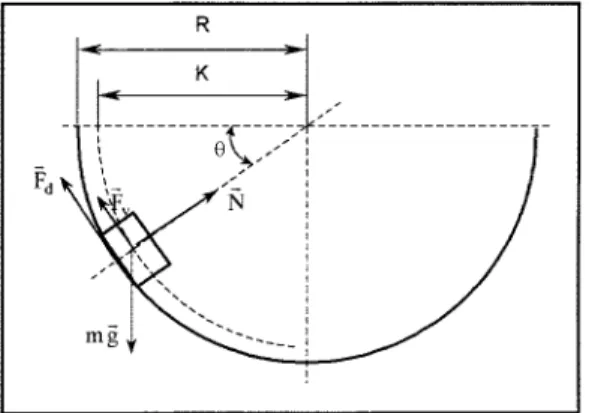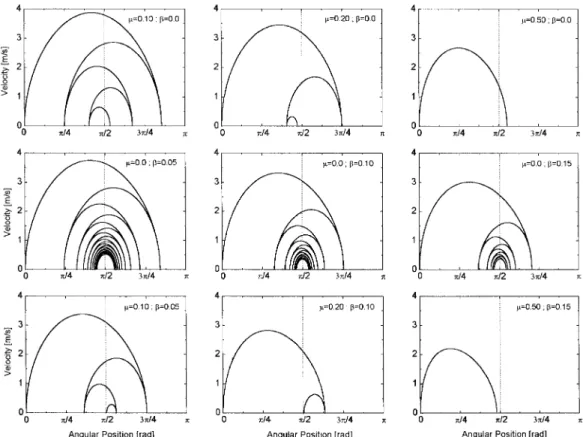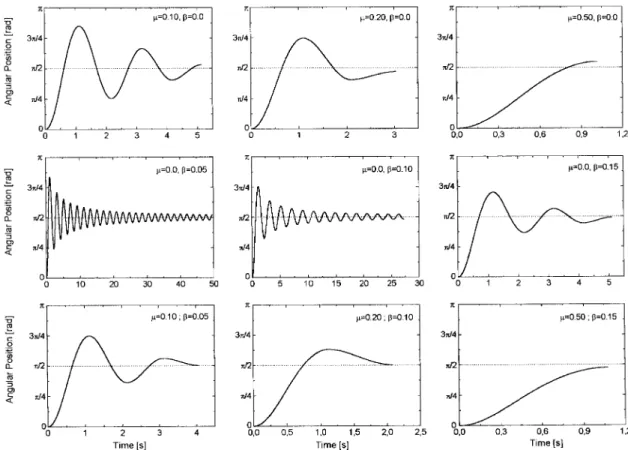Sliding Blok on a Semiirular Trak with Frition
A. J. Mania
,A. W. Mol,and C. S.S. Brand~ao
UniversidadeEstadual deSantaCruz,
65450-000Ilheus,BA, Brazil
Reebidoem19deagosto,2001. Aeitoem18deabril,2002.
This work presents the dynamis of a blok as it slides down a semiirular trak with both
Coulomb'sand visous fritions. Analytial solutionsand graphi forms of the equations for the
veloity,aeleration and energy asfuntions of angularpositionare displayedand disussed for
severalfritionoeÆients. Followingthesesolutionstheplotsasfuntionoftimeforthesedamped
motionsarealsopresented.
Eapresentadonestetrabalhoadin^amiadeumblooquandoestedeslizasobreumtrajeto
semi-irularnapresenadeambos osatritos, entresuperfies e visoso. Solu~oes analtias eformas
graasdasequa~oesparaaveloidade, aelera~aoeenergiaomofun~oesdaposi~aoangular s~ao
exibidase disutidaspara diversos oeientesdeatrito. Seguindoestes solu~oes, os graos em
fun~aodotempoparaestesmovimentosamorteidoss~aotambemapresentados.
I Introdution
Inoursesofintermediarymehanisitishelpfulto
in-trodue osillatory motions where no approximations
are made. The purpose is to familiarize the
stu-dentswithanellaboratedmathematialapparatusthat
desribes these experimentally observed motions,
al-though little theoretial disussions is found, mainly
when fritionfores are involved. In fat,these fores
are known to at opposing themotion (diretion
on-trarytothatofveloity),hangingindiretionforeah
half yle exeuted. Franklin and Kimmel[1℄, made
a study where ablok starts its motion from the top
of asemiirulartrakin thepresene of aCoulomb's
fritional fore. The parametersveloity, aeleration
and work performed bythefritionalfore in therst
quadrantwerefoundrelativetoahorizontalline
pass-ingthroughtheenteroftheirunfereneonstituing
thetrak, varyingthusitsposition from0until+=2.
Lapidus[2℄,extendedtheformerwork,onsideringnow
motion in the seond quadrant and where the blok
started from any initial position relative to a vertial
linevaryingfrom =2until+=2[2℄.
Weproposeheretostudythiskindoffritional
mo-tioninludingnowavisous foregenerallyonsidered
as resulting from the atmosphere. We assume that a
blokofmassm startsitsdownwardslidingmotionat
restonasemiirulartrakofradiusRfromapointin
someinitialangularposition
0
relativetoahorizontal
linepassingthroughtheenteroftheirunferene. We
alsoassumethattheforesofresistaneto themotion
are the Coulomb's fritional fore F
d
, proportional to
thesurfaereationandavisousforewithmagnitude
proportionaltov 2
,wherevisthetangentialveloityof
the blok relativeto thesurfae, Fig. 1. Thefore of
reationN duetotheontatwiththesurfaeisgiven
byN=mgsen+F
,whereF
istheentripetalfore
givenbymv 2
=K and K istheradiusof thetrajetory
desribed bythe enter ofmass ofthe blok. Initially
andin eahreturnpointitisneessaryforthemotion
toontinuethatthetangentialomponentofthe
grav-itational fore relative to the surfae be greater than
thefritionalfore. This onditionisgiven by>
, where = tan 1 s being s
the stati frition
o-eÆient. In fat, it is still possible to nd analytial
solutionsfor thedynami parametersifthis quadrati
approximation in theveloityis onsidered. Applying
Newton'sseondlawofmotionfortheblokthatslides
down yields the following equation for the tangential
aeleration:
a
t
=gos(gsin+ v 2 K ) m v 2 (1)
Ineahreturnpointthere isahange in thediretion
of motion. In thisway, ifmore thanthe rst half
y-le is to be found, substitution in the initial angular
positionisrequiredandthenegativesignalistobe
ap-plied when is inreasing, whilethe positivesignalis
to be employed when is dereasing. As before, it is
assumed that the visous fore F
v
is proportional to
v 2
and direted ontrary to the veloity of the blok,
F
v
= v
2
. Itisthuspossibletoextendtheresults
ob-tainedbyFranklinandKimmel[1℄. Theproportionality
onstant with dimension [mass/length℄ is an
intrin-siparameterthatdependsontheareaofontatAof
theblokwiththefritionalmedium, aswellasonthe
visosityoeÆient where theblokisimmersed. It
anthenbewrittenas=A.
Figure1.Blokslidingdownfromthetopofavertial
semi-irular trak of radiusR . The enter of mass exeutes a
motion followingthe radiusK,where K=R handhis
the half-heightof theblok. For simpliationsinthe
al-ulationswereonsideredR=1:1mandh=0:1mresulting
inatrajetoryofradiusK=1:0m.
II Results
Forthersthalf ylewritingEq. (1)asafuntion of
theangularposition andrearrangingtermsyields:
dv 2
d +v
2
=2gK(os sin) (2)
Forsimpliation weusethefollowingdenition:
=2(+ K
m
) (3)
Eq. (2) is a standard dierential equation whih an
alsobeanalitiallysolvedbymultiplyingbothsidesby
theintegratingfatorexp(),asindiatedbyFranklin
andKimmel[1℄ e ( dv 2 d +v 2 )= d d (v 2 e
)=2gK(os sin)e
(4)
Integrating from an initial angular position
0
to a nal position results in the following expression for the
quadrativeloity: v 2 = 2gK 1+ 2
f(+)os+(1 )sin [(+)os
0
+(1 )sin
0 ℄e
( 0)
g (5)
d
InTableI areshownthespeialvaluesofthedynami
parameters as numerially obtained. In the limiting
ase of no visous fore ( = 0) and with the speial
initial onditions
0
=0weget:
v 2
= 2gK
1+4 2
(3os+(1 2 2
)sin 3e 2
) (6)
This is in agreement with the previous work[1℄. The
proess anbe ontinued by reahing the next return
point, hanging now the initial angular position and
the signalfor the fritional fores in the Eq. (1). In
Fig. 2are shown urves of v as a funtion of after
severalylesof osillation. Itmustbenotedthat the
maximumvaluereahedbytheveloityisnotsituated
at =2, exept whenthere isno frition (= =0).
Mathematially thisan alsobe shown bynding the
maximal veloity asa funtion of . Using the same
relationsgivenbyEqs. (1-3)forthersthalfyleand
substituingtheexpressionforv 2
,Eq. (5),intoEq. (2),
dierentiatingandrearrangingthetermsyields:
a t = g 1+ 2
f(1 )os (+)sin+[(1 )sin
0
+(+)os
0 ℄e
( 0)
g (7)
InFig. 3aredisplayedtheurvesforthetangentialandentripetalaeleration(v 2
/K)asfuntionsofin several
ases. TheenergyspentbythefritionwhenthebloktravelsalengthKd isgivenby
dW = (F +F )Kd= (N+v 2
The total energy W
f
spent in the rst half yle an be found integrating the former expression or taking the
negativeofthediferenebetweenpotentialandkinetienergies. Thisresultsin
W
f
=mgKsin
0
mgK
+
1+ 2
[(sin os) (
1
+
sin
0 +os
0 )e
( 0)
℄ (9)
Theurvesarealsodisplayedin Fig. 3. Eq. (7)anbeusedforobtainingtheangularveloity _
()inthersthalf
yle. Usingthefatthatinitially _
0
=0(thisalsohappensin eahreturnpoint),yields:
d
dt =
s
2g
K(1+ 2
)
f(1 )sin+(+)os [(1 )sin
0
+(+)os
0 ℄e
(
0 )
g (10)
InFig. 4areshownurvesofosillationforseveralfritionoeÆientsaordingtothesesolutions.
=0.10 =0.20 =0.50 =0.0 =0.0 =0.0 =0.10 =0.20 =0.50
=0.0 =0.0 =0.0 =0.05 =0.10 =0.15 =0.05 =0.10 =0.15
v
max
3.8688 3.4562 2.6768 3.7535 3.3217 3.0126 3.3836 2.8226 2.2076
1.3190 1.1324 0.7745 1.2797 1.1044 0.9825 1.1155 0.8755 0.5966
v(=/2) 3.7888* 3.1856* 1.3595* 3.6476 3.0399 2.5646 3.1028 2.0985 stop
2.7803 1.4909 2.7641 1.9916 1.5426 1.7650
1.9511 2.2306 1.4845 1.1052 0.8991
1.2232 1.8717 1.1839 0.8617
0.5219 1.6129 0.9851 0.7063
1.4175 0.8437 0.5984
1.2644 0.7381 0.5190
1.1412 0.6561 0.4583
0.9555 0.5903
0.8839 0.5365
0.8224
R.Points 2.6722 2.3486 1.7220 2.6307 2.3731 2.2114 2.3557 1.9871 1.4966
0.7937 1.2673 0.7569 1.0162 1.1523 1.1362 1.5819
2.0910 2.2347 1.9965 1.8830 1.7662
1.2727 1.0090 1.2246 1.3213 1.5781
1.6644 2.0581 1.8627 1.7785
1.1401 1.3182 1.3927
1.9565 1.7934 1.7266
1.2212 1.3718 1.4321
1.8903 1.7507
1.2763 1.4066
1.8439
1.3163
Table I -It is shownherethe maximal veloities (in [m/s℄) reahed bythe blok and itsorrespondingangular
positions (in radians), values for the veloities when it rossesthe lowest point and at the return points(where
v=0) foreahhalf yleofosillation. Forthesevaluesinitiallyweuse
0
Figure2. Comparativeurvesfortheveloityasafuntionof. For=0:0 theurvesweretrunatedbeforereahingthe
Figure4.DampedmotionasafuntionoftimeforseveralCoulomb'sandvisousfritionoeÆients.
d
III Disussion
As seen in the aeleration urves with frition, the
maximumveloityours before =2(makingEq. (2)
equaltozero). Thereasonisthattheblokisunderthe
ation ofa diretion dependentresistive forewhile it
exeutesits semiirular motion. Thevalues givenby
Franklin and Kimmel[1℄, (3:7881, 3:1849, 1:3585) for
theveloities in =2when =0(for=0:1, 0:2and
0:5 respetively) are also numerially onrmed. The
returnpointsanbehekedbymakinguseofLapidus's
method[2℄, forthe sameonditionsasgiven above. In
the absene of both fritional fores we return to the
idealaseofanosillatingpendulumwithout
approxi-mationforsmallangles. Inthisasetheperiodanalso
beanalitially found bymeans of ellipti funtions[3℄,
whih results in a value of 2.367 seonds for alength
equalto 1m. We presenthereasuggestionfor
deter-mining the amplitudeand period of motion: to mark
theosillatorytrajetoryoveringthetrakwithpaper
andxing apen totheblok,although itanbe
diÆ-ulttodeterminethefritionoeÆientbetweenthese
surfaes.
Aknowledgments
Theauthors aregratefulltoUniversidadeEstadual
de SantaCruz forsupport and inentive. They thank
also Dr. A. K. T. Assisfor his assistane and
sugges-tions. This work was made asa partof the sienti
initiationprogramofthestudentC.S.S.Brand~ao,who
wouldliketo thank Conselho Naionalde
Desenvolvi-mentoCientoeTenologio(CNPq).
Referenes
[1℄ L. P.Franklin e P.I. Kimmel, Am.J. Phys. 48, 207
(1981).
[2℄ R.Lapidus,Am.J.Phys.49,883(1981).
[3℄ M. R. Spiegel, Theory and Problems of Advaned
Calulus, Shaum Publishing Co., New York (1962)


